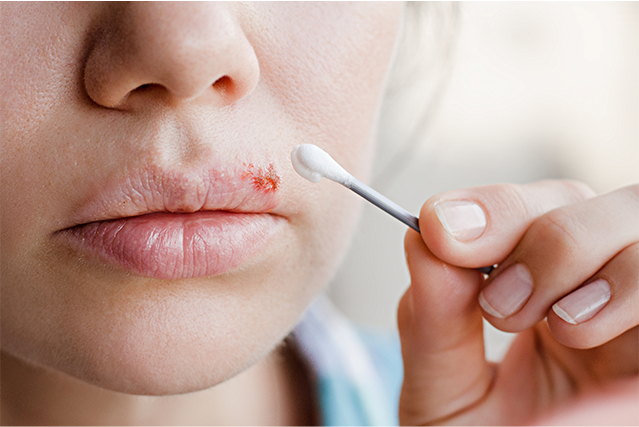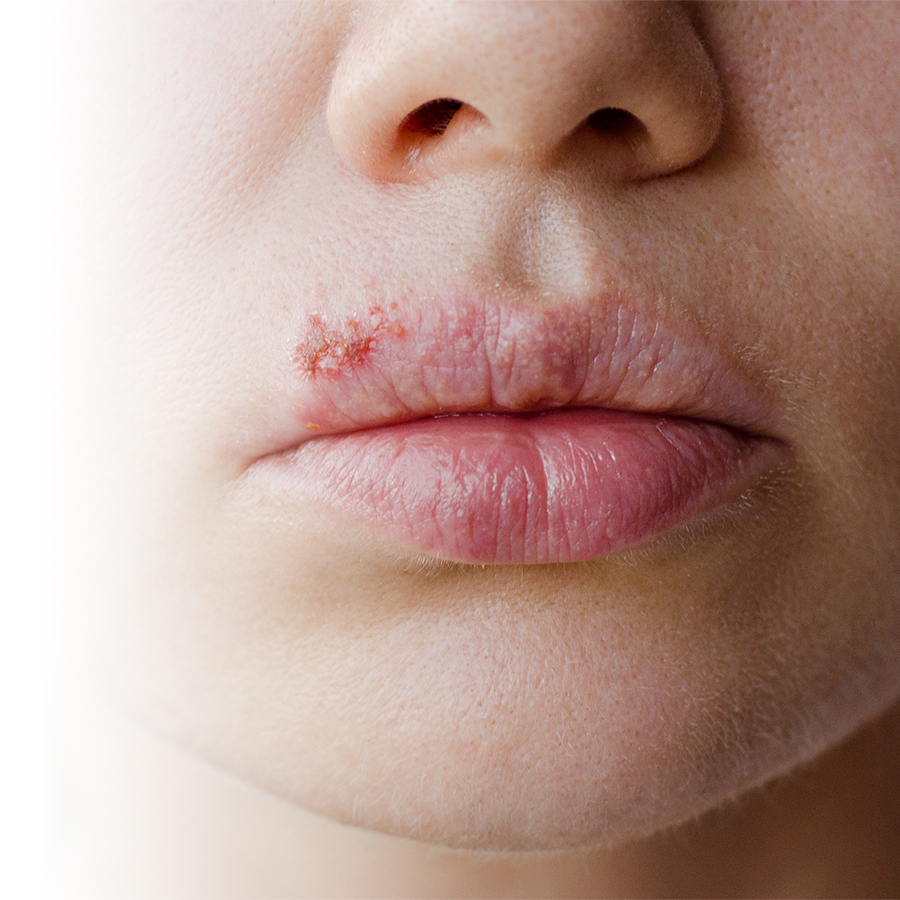What is a cold sore?
A cold sore (also called “herpes labialis” in medical terms) is an infection caused by a virus present in the body: the herpes simplex virus type 1 (HSV-1). According to the World Health Organization, an estimated 67% of individuals under the age of 50 are infected with HSV-1. Although it is usually contracted in childhood, this highly contagious virus can also be caught later in life.
After infection, the virus remains “latent”, but can cause periodic outbreaks if exposed to certain triggers. It is estimated that about one in four people experience recurrent episodes of cold sores. This means that many people are unknowingly carriers of the virus.
What causes cold sores?
Factors that can trigger the onset of cold sores include:
- ultraviolet rays (from the sun or tanning booths)
- cold weather
- dry skin on or around the lips
- fever, a cold or the flu
- stress
- fatigue
- menstruation, and
- trauma to the mouth (e.g. following oral surgery)
How long does a cold sore last?
Generally speaking, a cold sore lasts 8 to 10 days in total (14 days maximum).
How long is a cold sore contagious?
A cold sore is contagious two days before it appears and until the lesion has completely healed.
How can you get rid of a cold sore fast?
Starting treatment within the first few days of the onset of a cold sore, and ideally as soon as any telltale signs (such as tingling) appear, will reduce the intensity and duration of symptoms.
There is currently no cure for HSV-1 infection. Fortunately, cold sores disappear on their own over time. However, some prescription and over-the-counter treatments can help reduce their intensity and duration. These can be topical (ointment or cream) or in tablet form. There are also invisible patches that can be applied to the cold sore to cover and protect it from contamination while it heals.

Your pharmacist can prescribe a cold sore treatment following a consultation*
If you have had a prescribed cold sore treatment in the last five years and the prescription is no longer refillable, ask your pharmacist if they can re-prescribe it for you. They must conduct a consultation with you to assess your situation and check whether or not they can prescribe the treatment.
What are the different phases of a cold sore?
A cold sore outbreak, which is characterized by the eruption of a lesion, is usually preceded by certain warning signs.
|
Cold sore phase |
Symptoms |
|
Days 1 and 2: Tingling |
Before any visible symptoms appear, you may feel a tingling, itching or burning sensation. This phase lasts about six hours. The infection is already contagious at this stage, so it is important to avoid close physical contact with another person. |
|
Days 2 to 4: Blister |
The blister appears. A cluster of small painful vesicles multiply or grow. White blood cells travel to the blister and fight the infection. The blister fills with fluid (pus) and contains millions of virus particles. Herpes is very contagious during this stage. |
|
Day 4: Ulcer |
During the ulceration phase (typically the most painful), you will notice a thin cold sore forming. The inflammation can also cause a red ring around the affected area. |
|
Days 5 to 8: Crusting |
As the cold sore dries out, a golden-brown scab appears at the ulcer site. As the crust hardens, painful fissures may form and bleed. Intense itching or burning is also common. |
|
Days 8 to 10: Healing |
As the cold sore heals and the scab begins to detach, some dry scaling and residual swelling may occur. The skin may also remain slightly pink or red. |
How can cold sores be prevented?
If you or someone you know has a cold sore, here are a few steps you can take to avoid transmitting the virus:
- Avoid close or direct contact with others (e.g. kissing) until the cold sore is gone.
- The virus can also be transmitted through objects contaminated by saliva or the lesion, such as utensils, straws, lipstick, etc.
- Avoid touching the lesion directly. Scratching a cold sore can spread the infection to other areas of the face. Moreover, scratching can cause the virus to lodge under the fingernails, where it can be transported to other places conducive to its spread.
- Wash your hands often.
- Avoid contact between the mouth and genitalia during sexual relations.
Here are some ways to prevent cold sores if you are prone to them:
- Use a moisturizing lip balm regularly.
- Protect your lips from the sun's rays (some lip balms are designed to offer sun protection).
- When exposed to the cold, cover your mouth (with a scarf, for example).
- Avoid stress and fatigue.
- Avoid close contact with people who have colds or the flu.
Cold sore or pimple?
It can be difficult to tell the difference between a cold sore and a pimple. Here are a few things that can help you tell the difference:
- A pimple can appear anywhere on your face and lips and usually has a white or black head. Cold sores form fluid-filled blisters.
- Cold sores usually appear in one area each time and mainly on the lips, not on the face.
- They may be painful to the touch, but the sensation is different from a cold sore.
- Cold sores have a very distinctive itching, burning or tingling sensation at the onset.
- Cold sores form fluid-filled blisters.
- When in doubt, look for these symptoms and ask your pharmacist for advice.
Speak to your pharmacist to find out more about cold sores and how to treat them. Book an appointment.

